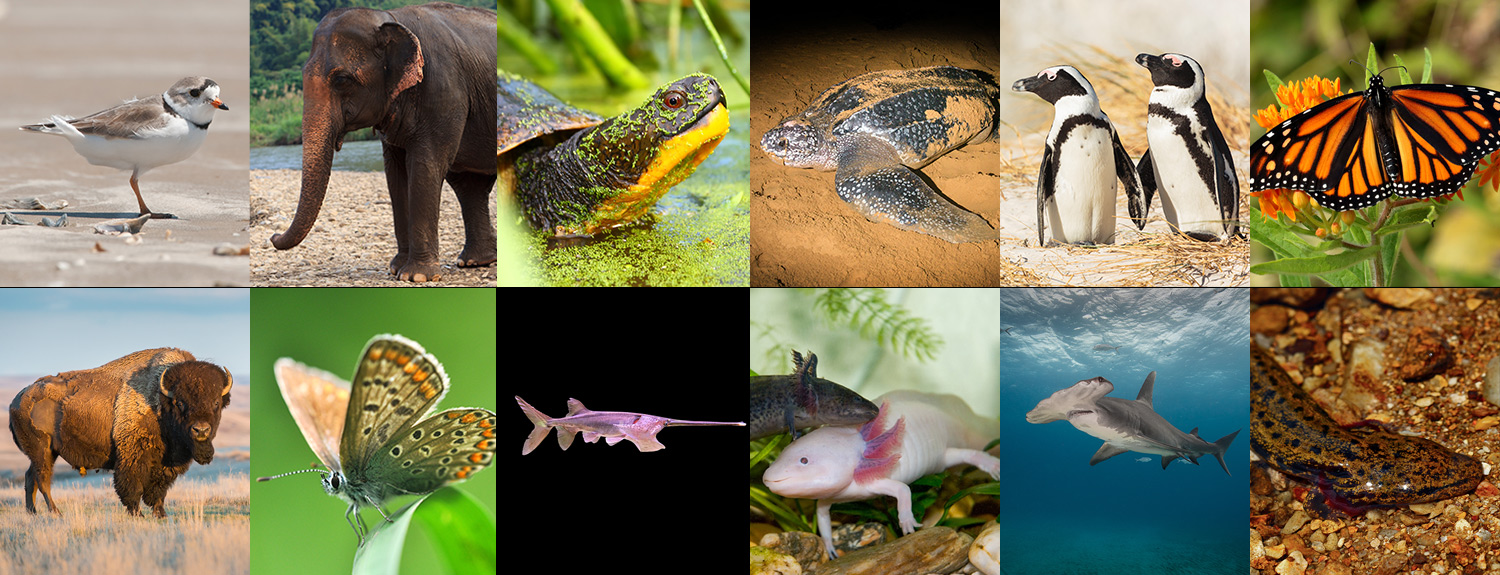
Earth Day 2020
50th Anniversary Edition
Published04/20/2020 , by Adam Hartman, gallery programs assistant
On April 22, 1970, 20 million Americans—10 percent of the U.S. population at the time—took part in a nationwide movement to promote environmental change, sparking a new era for environmental awareness and action that continues today, 50 years later.
Today, rising global temperatures threaten the survival of species across the planet. The ever increasing human population requires additional resources and shelter that are unsustainable on such a large scale, and habitat destruction for human development is a huge contributor to species’ population declines. Earth is our home—our ONLY home, and a surprisingly fragile one at that. Sure, it goes through a lot of changes on its own, but none of the natural processes it undergoes have had anywhere near the impact that humans have on shaping our planet’s climate.
But it’s not too late to slow the change. Only humans have the ability to begin the recovery of our planet. No other species can do it, and no other species is responsible for it. It is up to us to recognize our shortcomings and take action to protect not only our future, but the futures of the billions of other organisms we share this planet with.
For 2020, the Earth Day Network has identified 10 endangered or vulnerable species and habitats to focus their conservation efforts on. Conservation starts with education, and even from home you can help protect these, and other species just by familiarizing yourself with them. Understanding what makes these focal species so vulnerable is the first step to their recovery.
Read more about some of the official Earth Day Network species below. Each has been paired with an equally important Minnesota equivalent to bring the impacts closer to home. Even in Minnesota we have endangered or vulnerable species that we are familiar with. Together we can promote change, and do our part to ensure the survival of these, and many other species for generations to come.
For the full list of 2020 focal conservation species, click here.
To learn more about the history of Earth Day, click here.
And for more information about themes and goals of Earth Day 2020, as well as digital Earth Day events, click here.
Birds & Fish
This year’s bird and fish representatives are the African penguin (Spheniscus Demersus) and the great hammerhead (Sphyrna mokarran).
African Penguin
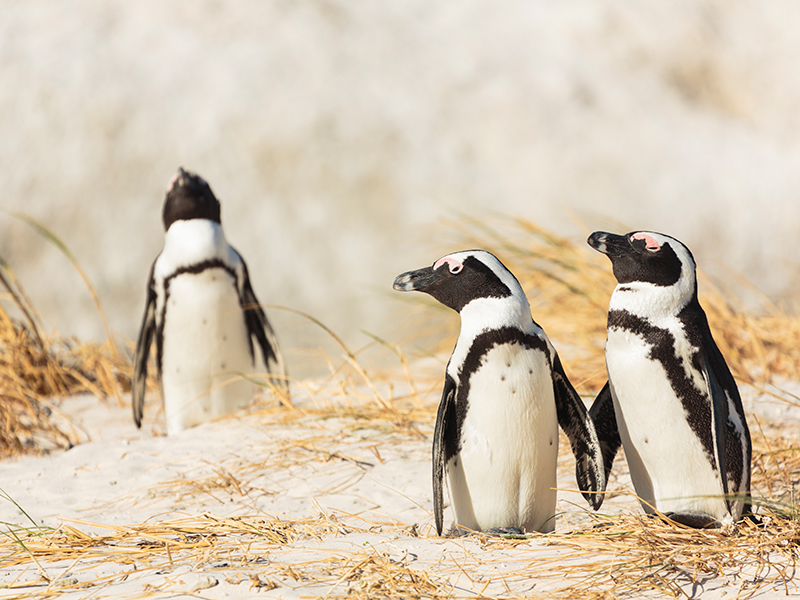
African penguins (Spheniscus Demersus) are the only penguinsnative to Africa. They can be found across the continent’s rocky, southern coast. Like all penguin species, African penguins are adept swimmers that are incapable of flight. Their feathers are small, overlapping, and waterproof to streamline their bodies and keep water off their skin. Their wings have evolved into flippers that propel them through the water to catch prey. African penguins can be easily distinguished from other species by the black band that runs across their body, their black feet, and the pink glands above their eyes. These glands are used for thermoregulation, receiving increased blood flow in hotter temperatures, turning more pink in the process. The glands are then cooled by the surrounding air, allowing the penguins to stay cool in the heat.
African penguin populations are on a steep decline, falling nearly 95% in the last century. With less than 50,000 penguins left in the wild today, the species will likely go extinct within the decade at the current rate of decline. The biggest threat to the survival of African penguins comes from humans. Oil spills off the African coast devastate populations and large-scale commercial fishing drastically reduces food availability for large colonies.
Their small size and clumsiness on land leaves African penguins defenseless against nest predation. At nesting sites, the guano the penguins use to build their nest is harvested for fertilizer, leaving their eggs exposed and vulnerable to heavy wind and bare rock. The eggs themselves are sold for food, and each female only lays one or two eggs per season.
Piping Plover

The piping plover (Charadrius melodus) is a small species of shorebird found along the sandy shores of the Atlantic Coast and the Great Lakes, as well as river sandbars across the central United States and Canada. It’s light, sandy brown plumage and bright orange legs and bill distinguish it from other darker shorebird species, and the black bands between its eyes and across its breast line are key identifiers.
Piping plovers mate for life. After arriving at their breeding grounds each spring, males begin scouting for nesting sites along the beach-grass line away from the water. They dig several depressions, called scrapes, at potential nesting sites. When a male has finished, the female will inspect each scrape and choose the one she finds most suitable. She will then decorate the surrounding area with shells and rocks to camouflage the nest from predators.
Unfortunately, these inconspicuous nests are often unintentionally destroyed by human activity. Waterside development and beach recreation are the largest threat to piping plovers today, though extensive conservation measures in recent decades have resulted in a steady increase in piping plover populations. While the piping plover is still endangered in its native ranges, the protection of breeding beaches and the restriction of motor vehicle use on and near nesting sites has impacted survival significantly.
Great Hammerhead

Hammerhead sharks get their name from their flattened hammer-shaped heads, called a cephalofoil. This head shape is unique to hammerheads and the traits associated with the shape make hammerheads highly specialized hunters.
Hammerheads’ eyes are positioned at either end of their head. This position of the eyes allows hammerheads to see in 360 degrees across the vertical plane, meaning they can see everything above and below them. Like other species of sharks, hammerheads have special electroreceptors in their head called ampullae of Lorenzini that detect small movements in the water around them. The increased surface area of their broad heads allows for directional detection of their prey’s movements. Hammerheads sweep their heads above the ocean floor, much like a metal detector, searching for bottom dwelling prey such as crustaceans, stingrays, and even other sharks!
The great hammerhead (Sphyrna mokarran) is currently endangered, and populations are decreasing. This species is not intentionally targeted by commercial fishermen, though its large fins make it a popular catch in the shark fin trading industry, where its fins are removed and used for shark fin soup. Still, many hammerheads die as bycatch on commercial fishing lines and nets which fill the coastal waters where hammerheads live.
American Paddlefish
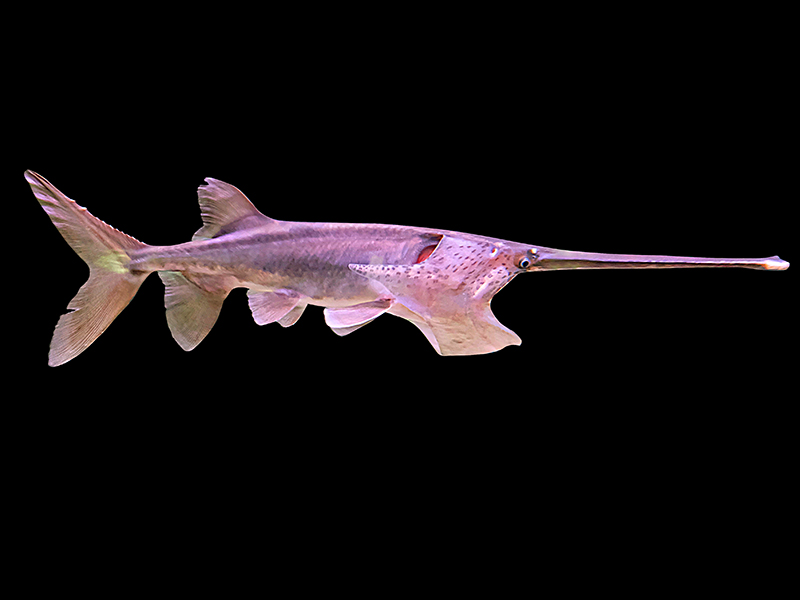
There are six documented species of paddlefish, only two of which survived into modern day—the American paddlefish (Polyodon spathula), and the Chinese paddlefish. The Chinese paddlefish is believed to have gone extinct as recently as 2010, with the last sighting being in January of 2003, making the American paddlefish the only surviving species.
Paddlefish are descended from a very primitive order of fishes that also includes sturgeon, called Acipenseriformes, which have remained relatively unchanged for millions of years. A key characteristic of both paddlefish and sturgeon is their cartilaginous endoskeleton—a characteristic commonly associated with sharks and rays; however, they are more closely related to bony fishes.
Paddlefish participate in mass spawning, which requires a very specific set of conditions to maximize offspring survivability. Eggs are fertilized externally, and require a gravel riverbed to attach to while they develop, which are most common in shallow, oxygen-rich waters. These spawning beds are scarce, and many adult paddlefish must migrate hundreds of miles to reach them. The construction of dams and alteration of waterways has blocked access to these spawning grounds over the last couple centuries, resulting in a decrease in paddlefish populations. Additionally, adult paddlefish are poached for their eggs which are used to make caviar, despite their protection in many states.
Invertebrates & Terrestrial Mammals
This year’s invertebrate and terrestrial mammal focal conservation species are the monarch butterfly (Danaus plexippus) and the Asian elephant (Elephas maximus).
Monarch Butterfly

Monarch butterflies (Danaus plexippus) might be the most popular and easily identifiable butterfly species in North America. Their striking orange and black patterned wings stand out in the forests and plains where they are commonly found. Their bright colors are an advertisement to potential predators, letting them know that they would not make a good meal. This type of warning coloration is referred to as aposematism. A monarch’s bright colors tell predators that it tastes bad, but in other species such as poison dart frogs and coral snakes, aposematic patterns indicate that the animal is poisonous, or venomous.
The monarch shares its colors and a similar pattern with the viceroy butterfly in a case of Müllerian mimicry, a type of mimicry where two similar-looking species with the same predators mimic each other’s warning patterns. Both monarchs and viceroys have an unpleasant taste, so those predators that have eaten one are unlikely to pursue another with the same warning patterns. Ultimately, both species benefit from reduced predation.
Like most butterfly species, monarchs are reliant on a small number of host plant species to lay their eggs. Milkweed (Asclepias spp.) is the monarch’s host plant—a common prairie plant in the United States and Canada where the monarchs breed. The increased use of agricultural herbicides has reduced the amount of milkweed in the monarch’s breeding grounds, causing a subsequent decrease in the number of monarch larvae that survive to adulthood.
Currently, monarch populations are still widespread, but the effects of climate change will likely create additional pressures that threaten the survivability of the species. Adult monarchs make an annual migration from their breeding grounds in the northern U.S. and southern Canada to their wintering grounds in Mexico—a distance of around 3000 miles! If global temperatures continue to increase, milkweed range will stretch further north into Canada, significantly increasing the distance monarchs must travel. The current 3,000 mile trek is already difficult enough, with many adults dying along the way, so a longer migration could have devastating effects on adult populations.
Karner Blue Butterfly
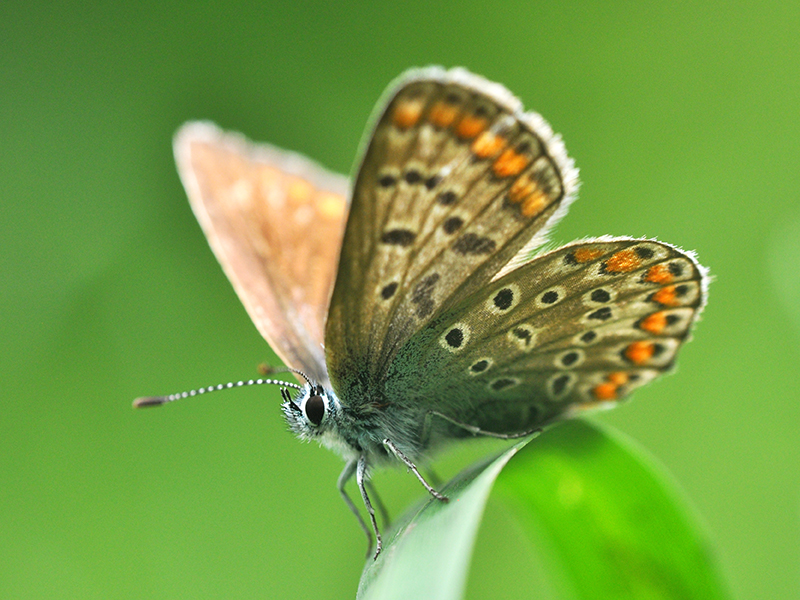
The Karner blue butterfly (Plebejus melissa samuelis) is a small species of butterfly with a wingspan of about one inch. Its range extends across the Great Lakes region from Minnesota to New Hampshire. Male and female butterflies are different colors. The top side of male wings are a light blue-violet whereas the female’s wings are a dark gray-brown, with a bit of blue closer to the body. The underside of both sex’s wings are a light gray with black speckling and an orange crescent border.
Adult Karner blues feed on the nectar from many different flowers which vary across regions, but Karner blue larvae feed solely on the leaves of wild lupine (Lupinus perennis). During their larval phase, Karner blue caterpillars share a mutualistic relationship with certain species of ants. The larvae secrete a small amount of liquid containing sugars and amino acids that the ants consume. In return, the ants provide protection from smaller predators and parasites. Larvae who are tended to by ants have a much higher survival rate than those who do not, and many localized populations are dependent on ants for their continued survival.
Karner blue butterflies were federally listed as an endangered in 1922. In the past century, wild lupine habitat has become fragmented due to habitat destruction for land conversion. Because Karner blue larvae feed only on wild lupine, the fragmentation and destruction of lupine habitats has resulted in a decrease in Karner blue populations. Adults do not migrate over the winter. Females lay eggs in the fall that hatch the following spring, so populations who are already limited by the range of wild lupine are trapped in dwindling habitats—incapable of migrating to new habitats that are few and far between.
Asian Elephant
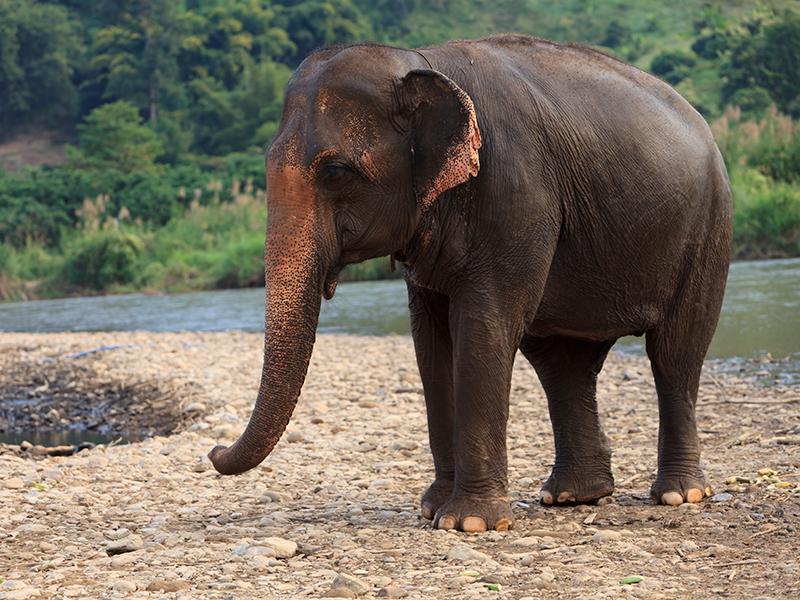
Slightly smaller than their African relatives, Asian Elephants (Elephas maximus) are the largest terrestrial mammals in Asia, standing 9 feet tall at the shoulder. Asian elephants eat around 300 pounds of food per day! They are both grazers and browsers, eating wet prairie grasses as well as roots, fruit, and bark from the tropical forests where they live.
Female elephants travel together in small herds led by an older female, the matriarch. Using her excellent memory, the matriarch leads the herd across territories, using consistent routes to move between areas with reliable food and water sources. Males are usually solitary, only meeting with herds briefly during mating periods, though small groups of bachelor males do sometimes form.
Asian elephants are listed as an endangered species, with less than 50,000 individuals left in the wild. Over the past 75 years, wild populations have decreased by more than 50 percent, largely due to interactions with humans. Much of the forests where the elephants live has been destroyed to make room for new developments and agriculture fields. In order to find enough food the elephants must leave the safety of the forest, often feeding on farmers’ crops. Being exposed makes the elephants easy targets for angry farmers, or poachers who hunt the elephants for their skin and tusks.
American Bison
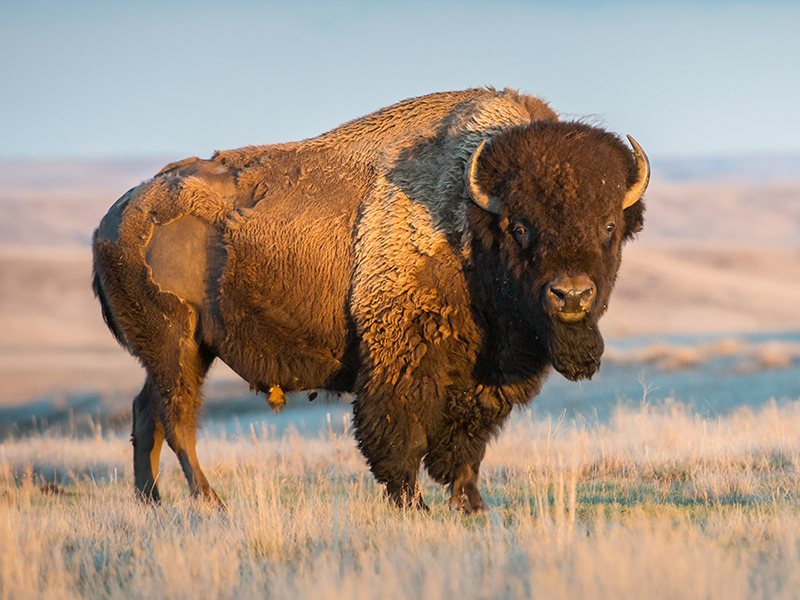
The American bison (Bison bison) is the largest terrestrial mammal in North America by weight, with some individuals weighing in at over one ton! Despite their large size and generally slow, lumbering movements, bison can reach speeds of 40 mph if they feel threatened.
Bison are year round grazers, spending every day cycling through three main activities resting, grazing, and chewing cud, or regurgitated plant matter. Even in the winter bison graze, pushing snow out of the way with their massive heads to reach dormant growth beneath the snow. During the winter months, bison grow a thick coat of fur to keep them warm. When spring arrives the bison shed this winter coat by rubbing against trees or wallowing. Wallowing is done by rolling around in dirt or mud, which also helps remove and repel parasites like ticks and flies.
Bison herds once spread across the North American plains, from Alaska to Mexico. Before 1800, populations are estimated to have reached between 30 million and 100 million individuals, but in the 1880s after decades of overhunting for meat and fur, the bison population fell below 500. Since the early 1900s, bison populations have risen significantly through breeding programs, reintroduction, and other conservation efforts. Currently, North America is home to around 500,000 bison, a small fraction of what it once was. Though the bison population will never fully recover due to urbanization and habitat fragmentation, the recovery of the American bison is a fantastic model for successful conservation efforts.
Reptiles & Amphibians
Leatherback turtles (Dermochelys coriacea) and axolotls (Ambystoma mexicanum)—the 2020 reptile and amphibian species of focus for the Earth Day Network’s conservation efforts.
Leatherback Turtle

Leatherback turtles (Dermochelys coriacea) are the largest living species of turtle in the world, reaching more than 7 feet in length and weighing up to 2,000 lbs! Their large size enables them to regulate their body temperature to some extent, a rare trait in reptiles, allowing leatherbacks to dive deeper and survive in colder waters than other sea turtle species. For this reason, leatherbacks have the widest distribution of any reptile species on the planet. They can be found throughout the Atlantic, Indian, and Pacifc oceans, and even the Meditteranean Sea!
Leatherbacks get their name from their unique carapace, or dorsal shell, which is covered in thick, blue skin that has a leathery texture. Most turtle shells are hard and bony, derived from the fusion of ribs and vertebrae, but leatherbacks are the only living species of sea turtle that lacks a bony shell. What it lacks in protection, it makes up for in speed. The longitudinal ridges across its back streamline its body as it moves through the water, allowing it to swim in bursts of speed up to 22 mph!
Leatherback turtle populations are declining largely due to increased contact with humans. They often mistake plastic bags for jellyfish, which make up most of their diet, causing them to suffocate or die due to blockage in their digestive tracts. Leatherback eggs are also harvested in large quantities from unprotected beaches, making it difficult to rebuild the population. Leatherback turtles have a 90% successful hatch rate, but less than 1% of hatchlings survive to sexual maturity.
Blanding’s Turtle

Blanding’s turtles (Emydoidea blandingii) are a medium sized turtle species, reaching anywhere from 5–10 inches long. They can be easily identified by their yellow chin and domed shell, which is speckled with flecks of yellow.
Blanding’s turtle shells are semi-boxed, meaning they can partially tuck themselves into their shells by pulling up the front end of their plastron, or bottom shell, which is hinged to protect their extremities when tucked away. Only the front third of the Blanding’s turtle’s plastron is hinged, so it cannot fully retract itself—unlike box turtles, whose plastrons are hinged near the midpoint.
Blanding’s grow slowly, becoming reproductively mature at 12 years old, and only lay one clutch of 10–26 eggs every year. Females will travel up to a mile away from their home wetland to lay their eggs in upland, sandy soil. When the young turtles hatch and emerge from their nests, they must travel to a nearby wetland. Many die from desiccation (drying out), predation, or automobile mortality along the way.
Adult Blanding’s turtles have few natural predators, and can live for more than 70 years. In the past, adult longevity compensated for young mortality, but today an increase in mortality from all age groups threatens the survival of the species. Habitat fragmentation and construction of roads has led to a huge decrease in Blanding’s turtle populations. The Blanding’s turtle is listed as endangered in much of its native range.
Axolotl

Axolotls (Ambystoma mexicanum) are close relatives of the tiger salamander, though unlike tiger salamanders and most other salamander species, axolotls retain their larval traits as adults, called neoteny. Adult axolotls retain their dorsal fins and external gills, which limits them primarily to aquatic life instead of semiaquatic like most other amphibians.
Axolotls are well-known for their ability to regrow body parts and are popular subjects in labs studying limb and tissue regeneration. Entire limbs can be severed, but instead of scarring axolotls can regrow lost limbs, bone and all—an unusual trait amongst vertebrates. Modern media focuses largely on pale pink axolotls, which were believed to be albino, but actually just have a variation in pigments, like out hair. These are the most common form of pet axolotl, but wild individuals are more commonly brown and speckled to blend into the murky waters of the lake bed.
Habitat destruction due to urban growth and introduction of exotic species are the leading causes for the decline in axolotl populations. Axolotls were originally native to only two lakes in Mexico, Lake Xochimilco and Lake Chalco. Lake Chalco has been fully drained, and Lake Xochimilco has been reduced to a series of canals now filled with carp and tilapia. Both are introduced species that feed on axolotl larvae and have had a devastating effect on wild populations. Axolotls remain a common, and popular pet, but wild axolotls are listed as critically endangered with an estimated 1000 individuals or fewer left in the wild. As amphibians, they are especially susceptible to pollution and are reliant on water for survival and reproduction. Their incredibly limited range and inability to travel between bodies of water like other amphibians has left them trapped and unable to recover their numbers.
Mudpuppy
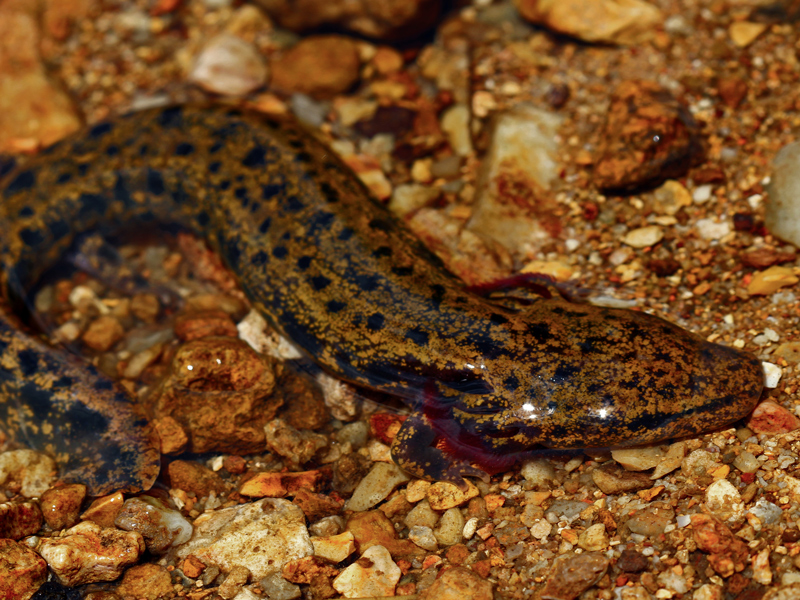
The common mudpuppy (Necturus maculosus), or waterdog, is the largest salamander species in Minnesota. Adults are 8–13 inches in length and are dark gray to brown in color with dark spotting patterns along their back to blend in with the mud and rocks. Like axolotls, mudpuppies are neotenous, retaining their larval traits, like their red gills, into adulthood.
Mudpuppies are Minnesota’s only fully aquatic salamander, spending their entire lives underwater. They live in well oxygenated streams, rivers, or lakes with gravel beds, which are good for egg attachment. Mudpuppies often find themselves caught on fishing lines baited with small fish, crayfish, or earthworms, which are all mudpuppy prey species. There’s a common misconception amongst those who catch them that their smooth, moist skin is poisonous, but mudpuppies produce no natural toxins.
Amphibians are incredibly susceptible to changes in water quality. They breathe through their thin, permeable skin which can absorb toxins from the water. Even trace amounts of toxic pollutants can decimate populations, which is why mudpuppies are a species of special concern in many areas. Siltation and chemical pollution poison waterways, and modification of habitats through dredging and damming reduce viable habitat. Today, the common mudpuppy is just that—common. However, populations across its range, including Minnesota, have declined in recent years due to pollution and habitat destruction.

